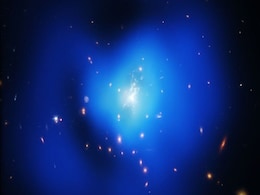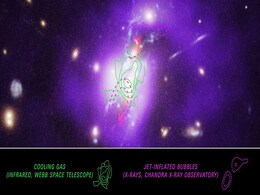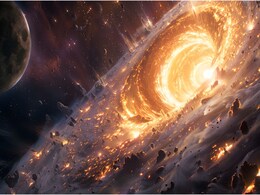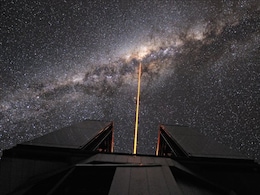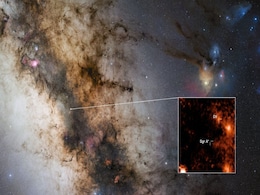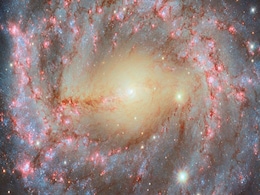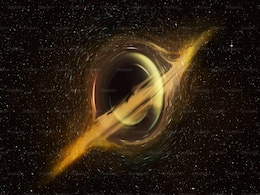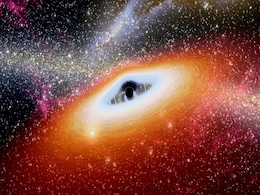Supermassive Stars
- All
- News
-

Supermassive Black Hole May Be Hiding in Large Magellanic Cloud, Scientists Suggest
- Monday March 10, 2025
- Written by Gadgets 360 Staff
A potential supermassive black hole may exist in the Large Magellanic Cloud, as per recent scientific findings. Researchers analysed hypervelocity stars moving at extreme speeds and found many could have been ejected from this neighbouring galaxy. The black hole is estimated to be around 600,000 times the mass of the Sun. If confirmed, this discove...
-
 www.gadgets360.com
www.gadgets360.com
-

Study Reveals Evidence of Supermassive Black Hole Inside Nearby Galaxy
- Friday March 7, 2025
- World News | Reuters
A study based on the trajectory of nine fast-moving stars observed at the fringes of the Milky Way provides strong evidence for the existence of a supermassive black hole inside the Large Magellanic Cloud.
-
 www.ndtv.com
www.ndtv.com
-

JWST Identifies Cooling Gas in Phoenix Cluster, Unlocking Star Formation Process
- Thursday February 20, 2025
- Written by Gadgets 360 Staff
The James Webb Space Telescope has detected the missing cooling gas in the Phoenix Cluster, a galaxy cluster located 5.8 billion light-years away. Researchers used the Mid-Infrared Instrument (MIRI) to identify gas at around 540,000 degrees Fahrenheit trapped in cavities within the cluster. This discovery resolves a long-standing mystery of how sta...
-
 www.gadgets360.com
www.gadgets360.com
-

Webb Telescope Unveils Hidden Process Behind Star Formation in Phoenix Cluster
- Friday February 14, 2025
- Written by Gadgets 360 Staff
NASA’s James Webb Space Telescope has uncovered the missing link in star formation within the Phoenix galaxy cluster. By mapping intermediate-temperature gas, researchers identified a crucial phase of cooling that was previously undetected. This discovery explains why the cluster’s supermassive black hole does not fully prevent star formation, ...
-
 www.gadgets360.com
www.gadgets360.com
-

Astronomers Spot Hundreds of Hidden Supermassive Black Holes Using Infrared
- Tuesday January 21, 2025
- Written by Gadgets 360 Staff
Hundreds of hidden supermassive black holes have been identified using infrared observations, offering fresh insights into their role in galaxy formation. Researchers relied on data from NASA's Infrared Astronomical Satellite (IRAS) and the Nuclear Spectroscopic Telescope Array (NuSTAR) to detect emissions from black holes obscured by thick clouds ...
-
 www.gadgets360.com
www.gadgets360.com
-

Astronomers Observe Black Hole Reactivate, Emitting Jets of Plasma
- Monday January 20, 2025
- Written by Gadgets 360 Staff
A supermassive black hole at the center of galaxy 1ES 1927+654 has been observed reactivating after a quiet period. Jets of hot gas were released from both sides of the black hole, surprising astronomers. Researchers speculate that a white dwarf star in close orbit may be interacting with the black hole, providing key insights into cosmic behavior....
-
 www.gadgets360.com
www.gadgets360.com
-

Hidden Supermassive Black Holes Found Behind Gas and Dust Across the Universe
- Thursday January 16, 2025
- Written by Gadgets 360 Staff
Supermassive black holes, which feed on surrounding material, may be more common than earlier believed. Researchers suggest that nearly 30%-50% of these black holes could be concealed behind dense gas and dust, making them invisible to standard telescopes. The study, based on infrared observations, sheds light on how these entities influence star f...
-
 www.gadgets360.com
www.gadgets360.com
-

Supermassive Black Hole Flashed Twice in a Rare Event, Scientists Explain the Reason
- Tuesday January 14, 2025
- Written by Gadgets 360 Staff
In a galaxy 408 million light-years away, the black hole ASASSN-22ci consumed a star from a binary system, producing a rare double-flash tidal disruption event (TDE). First observed in February 2022, a second flare occurred 720 days later, possibly caused by Hills capture. Researchers anticipate a third flare in early 2026, offering unprecedented i...
-
 www.gadgets360.com
www.gadgets360.com
-

A World-First Discovery - Twin Stars Trapped Orbiting Galactic Black Hole
- Wednesday December 18, 2024
- World News | The Conversation
At the centre of the Milky Way is a supermassive black hole called Sagittarius A*. It is roughly 27,000 light years from Earth and 23.5 million kilometres in diameter.
-
 www.ndtv.com
www.ndtv.com
-

Binary Star System D9 Found Orbiting Sagittarius A* Near Milky Way’s Core
- Thursday December 19, 2024
- Written by Gadgets 360 Staff
Astronomers have detected a young binary star system, D9, orbiting Sagittarius A*, the supermassive black hole at the Milky Way's centre. This challenges previous assumptions about star survival near intense gravitational forces. The discovery was made using the European Southern Observatory's Very Large Telescope. Future research with advanced tel...
-
 www.gadgets360.com
www.gadgets360.com
-

Hubble Captures NGC 5643’s Spiral Arms, Star Formation, and Hidden Black Hole
- Monday December 16, 2024
- Reported by Gadgets 360 Staff, Written by Gadgets 360 Staff
The NASA/ESA Hubble Space Telescope has captured detailed images of the spiral galaxy NGC 5643, located 40 million light-years away. This grand design galaxy features striking spiral arms outlined by young blue stars and dust clouds, with star-forming regions visible as pinkish hues. Ultraviolet and X-ray studies have revealed an active galactic nu...
-
 www.gadgets360.com
www.gadgets360.com
-

James Webb Space Telescope Reveals Unique Features of Westerlund 1 Star Cluster
- Saturday November 30, 2024
- Written by Gadgets 360 Staff
The James Webb Space Telescope has captured groundbreaking images of Westerlund 1, a supermassive star cluster located 12,000 light-years away. The new findings offer a closer look at star formation processes, particularly the discovery of brown dwarfs, and highlight the role of energetic radiation in shaping planetary environments.
-
 www.gadgets360.com
www.gadgets360.com
-

Two Black Holes With Unusual Behaviour Disrupt Traditional Theories About Their Formation
- Wednesday November 6, 2024
- Written by Gadgets 360 Staff
Astronomers are observing two unique black holes defying established cosmic theories. One, known as the "serial killer" black hole, is preparing to consume its second star in five years, an event that rarely occurs within such a timeframe. The other black hole, part of a triple system called V404 Cygni, has a structure that defies traditional black...
-
 www.gadgets360.com
www.gadgets360.com
-

Supermassive Black Hole at the Centre of the Milky Way Is Spinning Unexpectedly
- Sunday September 15, 2024
- Written by Gadgets 360 Staff
Sagittarius A* (pronounced Sagittarius A Star), the supermassive black hole at the centre of the Milky Way, is spinning in an unusual way, and scientists now believe they may know why. Based on new data from the Event Horizon Telescope, researchers suggest that this cosmic giant likely merged with another black hole billions of years ago. This colo...
-
 www.gadgets360.com
www.gadgets360.com
-

Supermassive Black Holes Might Be Responsible for the Death of a Galaxy, Says Study
- Friday August 23, 2024
- Gadgets 360 Staff
Supermassive black holes might be influencing galactic star formation and triggering the death of galaxies, claims a new stuy. Recent research has shed light on how the birth and death of a galaxy, also known as galactic cycle occurs. This study reveals that the mass of a supermassive black hole can significantly impact the amount of cold gas avail...
-
 www.gadgets360.com
www.gadgets360.com
-

Supermassive Black Hole May Be Hiding in Large Magellanic Cloud, Scientists Suggest
- Monday March 10, 2025
- Written by Gadgets 360 Staff
A potential supermassive black hole may exist in the Large Magellanic Cloud, as per recent scientific findings. Researchers analysed hypervelocity stars moving at extreme speeds and found many could have been ejected from this neighbouring galaxy. The black hole is estimated to be around 600,000 times the mass of the Sun. If confirmed, this discove...
-
 www.gadgets360.com
www.gadgets360.com
-

Study Reveals Evidence of Supermassive Black Hole Inside Nearby Galaxy
- Friday March 7, 2025
- World News | Reuters
A study based on the trajectory of nine fast-moving stars observed at the fringes of the Milky Way provides strong evidence for the existence of a supermassive black hole inside the Large Magellanic Cloud.
-
 www.ndtv.com
www.ndtv.com
-

JWST Identifies Cooling Gas in Phoenix Cluster, Unlocking Star Formation Process
- Thursday February 20, 2025
- Written by Gadgets 360 Staff
The James Webb Space Telescope has detected the missing cooling gas in the Phoenix Cluster, a galaxy cluster located 5.8 billion light-years away. Researchers used the Mid-Infrared Instrument (MIRI) to identify gas at around 540,000 degrees Fahrenheit trapped in cavities within the cluster. This discovery resolves a long-standing mystery of how sta...
-
 www.gadgets360.com
www.gadgets360.com
-

Webb Telescope Unveils Hidden Process Behind Star Formation in Phoenix Cluster
- Friday February 14, 2025
- Written by Gadgets 360 Staff
NASA’s James Webb Space Telescope has uncovered the missing link in star formation within the Phoenix galaxy cluster. By mapping intermediate-temperature gas, researchers identified a crucial phase of cooling that was previously undetected. This discovery explains why the cluster’s supermassive black hole does not fully prevent star formation, ...
-
 www.gadgets360.com
www.gadgets360.com
-

Astronomers Spot Hundreds of Hidden Supermassive Black Holes Using Infrared
- Tuesday January 21, 2025
- Written by Gadgets 360 Staff
Hundreds of hidden supermassive black holes have been identified using infrared observations, offering fresh insights into their role in galaxy formation. Researchers relied on data from NASA's Infrared Astronomical Satellite (IRAS) and the Nuclear Spectroscopic Telescope Array (NuSTAR) to detect emissions from black holes obscured by thick clouds ...
-
 www.gadgets360.com
www.gadgets360.com
-

Astronomers Observe Black Hole Reactivate, Emitting Jets of Plasma
- Monday January 20, 2025
- Written by Gadgets 360 Staff
A supermassive black hole at the center of galaxy 1ES 1927+654 has been observed reactivating after a quiet period. Jets of hot gas were released from both sides of the black hole, surprising astronomers. Researchers speculate that a white dwarf star in close orbit may be interacting with the black hole, providing key insights into cosmic behavior....
-
 www.gadgets360.com
www.gadgets360.com
-

Hidden Supermassive Black Holes Found Behind Gas and Dust Across the Universe
- Thursday January 16, 2025
- Written by Gadgets 360 Staff
Supermassive black holes, which feed on surrounding material, may be more common than earlier believed. Researchers suggest that nearly 30%-50% of these black holes could be concealed behind dense gas and dust, making them invisible to standard telescopes. The study, based on infrared observations, sheds light on how these entities influence star f...
-
 www.gadgets360.com
www.gadgets360.com
-

Supermassive Black Hole Flashed Twice in a Rare Event, Scientists Explain the Reason
- Tuesday January 14, 2025
- Written by Gadgets 360 Staff
In a galaxy 408 million light-years away, the black hole ASASSN-22ci consumed a star from a binary system, producing a rare double-flash tidal disruption event (TDE). First observed in February 2022, a second flare occurred 720 days later, possibly caused by Hills capture. Researchers anticipate a third flare in early 2026, offering unprecedented i...
-
 www.gadgets360.com
www.gadgets360.com
-

A World-First Discovery - Twin Stars Trapped Orbiting Galactic Black Hole
- Wednesday December 18, 2024
- World News | The Conversation
At the centre of the Milky Way is a supermassive black hole called Sagittarius A*. It is roughly 27,000 light years from Earth and 23.5 million kilometres in diameter.
-
 www.ndtv.com
www.ndtv.com
-

Binary Star System D9 Found Orbiting Sagittarius A* Near Milky Way’s Core
- Thursday December 19, 2024
- Written by Gadgets 360 Staff
Astronomers have detected a young binary star system, D9, orbiting Sagittarius A*, the supermassive black hole at the Milky Way's centre. This challenges previous assumptions about star survival near intense gravitational forces. The discovery was made using the European Southern Observatory's Very Large Telescope. Future research with advanced tel...
-
 www.gadgets360.com
www.gadgets360.com
-

Hubble Captures NGC 5643’s Spiral Arms, Star Formation, and Hidden Black Hole
- Monday December 16, 2024
- Reported by Gadgets 360 Staff, Written by Gadgets 360 Staff
The NASA/ESA Hubble Space Telescope has captured detailed images of the spiral galaxy NGC 5643, located 40 million light-years away. This grand design galaxy features striking spiral arms outlined by young blue stars and dust clouds, with star-forming regions visible as pinkish hues. Ultraviolet and X-ray studies have revealed an active galactic nu...
-
 www.gadgets360.com
www.gadgets360.com
-

James Webb Space Telescope Reveals Unique Features of Westerlund 1 Star Cluster
- Saturday November 30, 2024
- Written by Gadgets 360 Staff
The James Webb Space Telescope has captured groundbreaking images of Westerlund 1, a supermassive star cluster located 12,000 light-years away. The new findings offer a closer look at star formation processes, particularly the discovery of brown dwarfs, and highlight the role of energetic radiation in shaping planetary environments.
-
 www.gadgets360.com
www.gadgets360.com
-

Two Black Holes With Unusual Behaviour Disrupt Traditional Theories About Their Formation
- Wednesday November 6, 2024
- Written by Gadgets 360 Staff
Astronomers are observing two unique black holes defying established cosmic theories. One, known as the "serial killer" black hole, is preparing to consume its second star in five years, an event that rarely occurs within such a timeframe. The other black hole, part of a triple system called V404 Cygni, has a structure that defies traditional black...
-
 www.gadgets360.com
www.gadgets360.com
-

Supermassive Black Hole at the Centre of the Milky Way Is Spinning Unexpectedly
- Sunday September 15, 2024
- Written by Gadgets 360 Staff
Sagittarius A* (pronounced Sagittarius A Star), the supermassive black hole at the centre of the Milky Way, is spinning in an unusual way, and scientists now believe they may know why. Based on new data from the Event Horizon Telescope, researchers suggest that this cosmic giant likely merged with another black hole billions of years ago. This colo...
-
 www.gadgets360.com
www.gadgets360.com
-

Supermassive Black Holes Might Be Responsible for the Death of a Galaxy, Says Study
- Friday August 23, 2024
- Gadgets 360 Staff
Supermassive black holes might be influencing galactic star formation and triggering the death of galaxies, claims a new stuy. Recent research has shed light on how the birth and death of a galaxy, also known as galactic cycle occurs. This study reveals that the mass of a supermassive black hole can significantly impact the amount of cold gas avail...
-
 www.gadgets360.com
www.gadgets360.com



